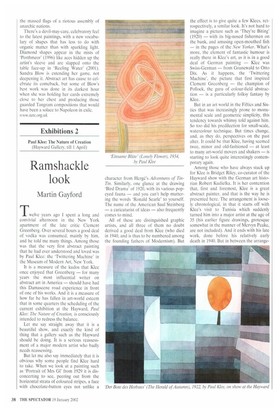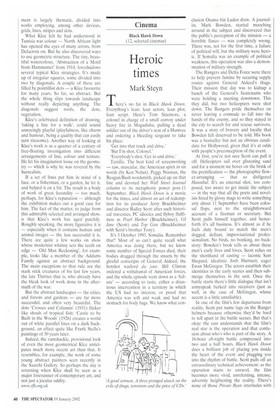Paul Klee: The Nature of Creation (Hayward Gallery. till 1 April)
Ramshackle look
Martin Gaylord
Twelve years ago I spent a long and convivial afternoon in the New York apartment of the late critic Clement Greenberg. Over several hours a good deal of vodka was consumed, mainly by him, and he told me many things. Among those was that the very first abstract painting that he had ever understood and loved was by Paul Klee: the 'Twittering Machine' in the Museum of Modern Art, New York.
It is a measure of the kudos that Klee once enjoyed that Greenberg — for many years the most influential writer on abstract art in America — should have had this Damascene road experience in front of one of his works. And it is a measure of how far he has fallen in art-world esteem that in some quarters the scheduling of the current exhibition at the Hayward, Paul Klee: The Nature of Creation, is consciously intended to redress the balance.
Let me say straight away that it is a beautiful show, and exactly the kind of thing that a gallery such as the Hayward should be doing. It is a serious reassessment of a major modern artist who badly needs reassessing.
But let me also say immediately that it is obvious why some people find Klee hard to take. When we look at a painting such as 'Portrait of Mrs GI' from 1929 it is disconcerting to see, peering out from the horizontal strata of coloured stripes, a face with chocolate-button eyes not unlike a character from Herge's Adventures of TinTin. Similarly, one glance at the drawing 'Bird Drama' of 1920, with its various popeyed fauna — and you can't help muttering the words 'Ronald Searle' to yourself. The name of the American Saul Steinberg — a caricaturist of ideas — also frequently comes to mind.
All of these are distinguished graphic artists, and all three of them no doubt derived a good deal from Klee (who died in 1940, and is thus to be numbered among the founding fathers of Modernism). But the effect is to give quite a few Klees, retrospectively, a similar look. It's not hard to imagine a picture such as 'They're Biting' (1920) — with its big-nosed fishermen on the bank, and amusing open-mouthed fish — in the pages of the New Yorker. What's more, the element of fantastic humour is really there in Klee's art, as it is in a good deal of German painting — Klee was Swiss-German — from Grunevvald to Otto Dix. As it happens, the 'Twittering Machine', the picture that first inspired Clement Greenberg — the champion of Pollock, the guru of colour-field abstraction — is a particularly folksy fantasy by Klee.
But in an art world in the Fifties and Sixties that was increasingly prone to monumental scale and geometric simplicity, this tendency towards whimsy told against him. So too did his predilection for small-scale, watercolour technique. But times change, and, as they do, perspectives on the past alter. It could be that Klee, having seemed twee, minor and old-fashioned — at least to many art-world movers and shakers — is starting to look quite interestingly contemporary again.
Among those who have always stuck up for Klee is Bridget Riley, co-curator of the Hayward show with the German art historian Robert Kudielka. It is her contention that, first and foremost, Klee is a great abstract painter, and that is the way he is presented here. The arrangement is loosely chronological, in that it starts off with Klee's visit to Tunisia which suddenly turned him into a major artist at the age of 35 (his earlier figure drawings, grotesque somewhat in the manner of Mervn Peake, are not included). And it ends with his late work, done before his relatively early death in 1940. But in between the arrange ment is largely thematic, divided into works employing, among other devices, grids, lines, stripes and dots.
What Klee felt he had understood in Tunisia was colour — North African light has opened the eyes of many artists, from Delacroix on. But he also discovered ways to use geometric structure. The tiny, beautiful watercolour, 'Abstraction of a Motif from Hammamer from 1914, foreshadows several typical Klee strategies. It's made up of irregular squares, some divided into two by diagonals. A couple of these are filled by pointillist dots — a Klee favourite for many years. So far, so abstract. But the whole thing slips towards landscape without really depicting anything. The diagonals suggest roofs, the dots. vegetation.
Klee's celebrated definition of drawing, 'taking a line for a walks, could sound annoyingly playful (playfulness, like charm and humour, being a quality that can easily turn tiresome). Another way of looking at Klee's work is as a quarter of a century of free-floating investigation into different arrangements of line, colour and texture. He let his imagination loose on the geometry — which is why he was revered by the Surrealists.
If a set of lines put him in mind of a face, or a fisherman, or a garden, he let it, and helped it on a bit. The result is a body of work of great fecundity — too much, perhaps, for Klee's reputation — although the exhibition makes out a good case for him. The fact of the matter, to judge from this admirably selected and arranged show, is that Klee's work has aged patchily. Roughly speaking, the more figurative it is — especially when it contains human and animal images — the less successful it is. There are quite a few works on show whose modernist whimsy sets the teeth on edge — 'Old Man Reckoning', for example, looks like a member of the Addams Family against an abstract background. The main exceptions to that rule are the stark stick creatures of his last few years, the late Thirties that is, who already have the bleak look of work done in the aftermath of the war.
But the abstract landscapes — the cities, and forests and gardens — are far more successful, and often very beautiful. The dots 'Crosses and Columns' (1931) flicker like shoals of tropical fish: 'Castle to be Built in the Woods' (1926) creates a world out of white parallel lines on a dark background, an effect quite like Frank Stella's paintings of 30 years later.
Indeed, the ramshackle, provisional look of even the most geometrical Klee anticipates much more recent art than that. It resembles, for example, the work of some young abstract painters seen recently in the Saatchi Gallery. So perhaps the day is returning when Klee shall be seen as a major forerunner of contemporary art, and not just a jocular oddity.
www.ifh.org.uk































































 Previous page
Previous page